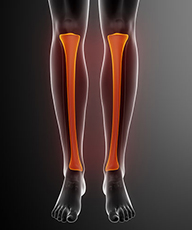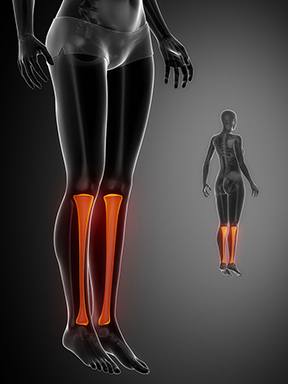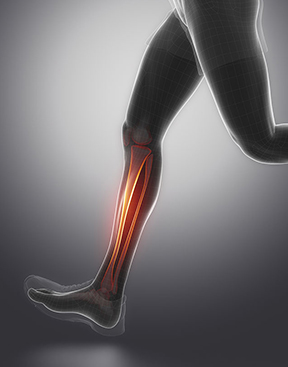The sharp splintering pain of shin splints makes you stop in your tracks. Every time you feel ready to try a longer hike or a faster run, your shin pain is right there waiting for you. Also known as medial tibial stress syndrome, shin splints is an overuse injury that happens if you do too much too soon. Especially after doing too little for too long.
Even though the pain settles with rest, rest alone won’t solve the problem. If left untreated and ignored, the continued bone stress on your shin will ultimately lead to a tibial stress fracture.

What is Shin Splints?
Shin splints, or medial tibial stress syndrome, is a cumulative bone stress disorder. In other words, it doesn’t happen overnight, but rather from repeated loading on your shin without enough rest. Many people underestimate how important rest is, but the recovery time in between exercise is crucial for your body to naturally repair and restore the bone.
Ignoring your shin pain, means a gradual weakening of the area and the constant pounding causes minute cracks in the bone. Your body can repair the cracks if given enough time to rest and recover. However, if you don’t rest, the tiny cracks progress to a complete stress fracture.
I have a Shin Splints – What went wrong?
Shin splints is a general term describing the pain felt over the front of your lower leg. It usually happens during or after exercise, but can also occur after walking a long distance or up a steep incline.
But why does it happen? The muscles and tendons attached to your shin bone control your ankle movements and distribute the load, or stress, over the soft tissue, bone and joints. For instance, when you jump, the muscles and tendons not only lift your feet off the floor, but also help to absorb and distribute the impact when you land. Otherwise your whole foot will hit the floor after every hop. That’s just one example of how the muscles and tendons should work together to decrease stress on your shin bone.
Things start to go wrong when the non-stop strain on your shin leads to inflammation, swelling and muscle spasm. The constant tension of your calf muscles on your shin results in small tears in the tendons and inflammation of the bone. This local reaction increases the pressure on the bone even more, resulting in a vicious cycle of inflammation and pain.

Causes of Shin pain
- Increasing the intensity of your training i.e. too fast, too far, too soon.
- Stop-start activities, e.g. running, tennis, soccer.
- Repetitive high impact landing.
- Running on uneven ground, down a slope or incline.
- Tight calf muscles.
- Running on hard surfaces e.g. running barefoot on a tar road.
- Worn out shoes.
- Flat feet.
- High BMI.
- Calf muscle weakness.
- Tight hip muscles.
How bad is my Shin Splints?
At first, your shin pain won’t bother you all that much. You will notice some tightness in your calf muscles, and an ache over your shins when you run. In the early stages of shin splints, this ache goes away when you warm up and only the tightness in your muscles remains. For now, you can easily ignore your painful shins.
After awhile, the dull ache becomes definite discomfort when you exercise. As soon as you pick up the pace on your run, the sharp, burning pain makes you slow down. The more you run, the worse it gets, until you have to slow down to a walk to get back home. The pain takes longer to settle after each run, and the tightness in you calf muscles is your constant companion. Your shin pain feels better the morning after training, but pressure or a bump against your shin makes you take notice of your unhappy shins.
If left, untreated, this constant discomfort turns into severe pain that keeps you from falling asleep at night. Even just walking fast is painful now, not to mention walking up an incline. Any pressure on your shin is excruciating and the whole front of your shin feels swollen and inflamed. Running at any pace is impossible due to pain, and the thought of jumping will make you cringe.
Diagnosis
Physiotherapy diagnosis
Through a physical exam, our physiotherapists diagnose the cause(s) of your shin pain and advise you on the right treatment plan for your problem. We perform a number of tests including stress tests, muscle length testing, neuromuscular control and neural tests to find the root cause of your shin splits. A tuning fork is a useful, non-invasive tool we can use if we suspect a stress fracture. If your pain gets worse when the tuning fork is placed on the injured area, this will raise our suspicion that you have a stress fracture. Even though this test isn’t definitive, a negative test can be up to 92% sensitive to exclude a stress fracture.
X-rays
X-rays are not useful to diagnose medial tibial stress syndrome. If your shin pain has already progressed to a stress fracture, an x-ray might show periosteal thickening as the injury starts to heal. However, a normal X-ray does not exclude a tibial stress fracture.
Diagnostic ultrasound
From a physiotherapy point of view, an ultrasound scan is more useful as a diagnostic tool, apart from our clinical assessment. Although an ultrasound doesn’t show the bony elements, it does visualize swelling around the bone, indicative of either a stress fracture or shin splints.
MRI
An MRI scan shows all of the structures in your lower leg, including soft tissue, bones, nerves and blood vessels. In the case of a stress fracture, this scan will show an inflammatory reaction and swelling of the bone. However, these scans are extremely costly and usually not necessary to diagnose shin pain.
Scintigraphy
Also known as scintigraphy, this imaging is less expensive than an MRI, and can also be used to confirm a stress fracture. However, scintigraphy is more invasive, because it involves injection of a radioactive chemical. Specialized equipment detects the radiation from this chemical, and a computer forms an image. If there is a stress fracture, that area of the bone will show increased uptake of the radioactive chemical.
Why is the pain not going away?
The first rule of shin splints is to rest your leg. Take away the aggravating factor. That doesn’t mean you can’t do any form of exercise, but you have to rest from the thing that originally caused your pain. Shin splints is your body’s way of showing you that you are doing more than it can handle. We usually see people come back over and over again due to shin splints, because:
- They are not resting as recommended.
- Not doing their home exercise protocol.
- Failure to complete their rehabilitation program.
- Going back to their sporting activity too soon.
- Increasing how hard they train when the pain settles.
- Using medication to numb and ignore the pain while they keep training.
- Not paying attention to their nutrition.
Problems we see when patients come to us with Shin Pain
Fractures are the most common complications we encounter from patients who have ignored their shin pain for too long.
Stress fracture
There are two major causes of stress fractures. These are when an abnormal force is placed on a normal bone, or when a normal force is placed on abnormal bone.
Abnormal force means that the force you apply is more than what your body can handle. Most commonly this is overtraining over a prolonged period of time. Abnormal bone means that there is something wrong with the bone itself. Examples are low bone density, osteoporosis, osteochondritis, and the female triad seen in very active female athletes.
Tibia fracture
A fracture is the worst case scenario of ignoring shin pain. This happens when you don’t stop activity that caused the shin splints in the first place. Where a stress fracture is a line fracture within the bone, like a small crack, a tibia fracture is where the crack turns into and actual fracture. In other words a broken bone. This happens when you do not comply with the rest and treatment advised. Unfortunately, the recovery process for a tibia fracture is much longer than shin splints, and includes a period of immobilization where we have to take all the weight off of your leg. You will be in a cast or moon boot for 6-8 weeks, and on crutches until the fracture has healed. So it really is worth listening to your body at the very first signs of shin splints!

Physiotherapy treatment
Although rest is crucial in the early days with shin splints, too much rest leads to a basket of other problems like joint stiffness, muscle weakness, tightness and impaired proprioception.
Your physiotherapist is an expert when it comes to guiding you in finding the balance between rest and activity. The key is load management, not taking all the load away. In the first week after your injury, this means mostly resting, but as soon as the pain settles we need to start gentle movements. After all, movement is medicine. This will include low impact exercises, like gently moving the joints around your knee and ankle.
As medical professionals, physiotherapists have a wide range of treatment modalities and techniques to help you through each phase of healing. These include modalities like dry needling, laser to stimulate healing, strapping to relieve stress on the bone, soft tissue mobilization and myofascial release to treat tightness and restrictions and, of course, gradual increase in load to make sure your shin bone is prepared for your day to day activities.
Phases of rehabilitation
1st Phase: Pain relief and Protection
Our first aim is to get the proper diagnosis and identify and prioritize any contributing factors to your unique problem. Now, we can guide you in avoiding any aggravating activities for the time being and managing your symptoms. Most of our treatment during this phase is focused on pain relief and relieving pressure on your shin. This might include a moon boot or crutches, depending on your pain.
At the end of this phase you should be able to take weight on your leg without severe pain and not wake up due to pain at night.
2nd Phase: Initial loading
Once you can take some weight on your leg, we will start with low intensity exercises to encourage blood circulation and healing. Movement also helps with pain relief, but we will carefully monitor how much movement we allow during this phase. While we continue treatment for pain relief, we will also add more soft tissue mobilization and range of movement exercises. By now we will start increasing load on your leg, without overloading the injured tissue.
By the end of this phase you should be able to take full weight on your leg, with or without support. You should have minimal pain with walking, no pain when sitting still and no pain at night.
3rd Phase: Tissue adaptation
This phase will focus on optimal loading to stimulate the healing tissue in your shin. Optimal loading varies from person to person, and injury to injury, so this will be adapted to your phase of recovery. We will also start addressing any biomechanical factors that contributed to your shin splits. Exercises will start to include more weight-bearing to encourage the injured leg to do its share of the work again.
By the end of this phase you should be able to start some jogging once or twice a week, but not on hard surfaces yet. You should also be able to do a heel raise without pain and stretch your calf muscles without pain.
4th Phase: Loading and strengthening
Shin splints is known for recurring, so this is the phase where you have to really keep your commitment and discipline. Tissue adaptation takes time, so simply feeling less pain doesn’t mean the work stops. This is also the longest phase of your rehabilitation program, and usually starts at about week 5 or 6. Now we start building up stress tolerance and strength in your leg. A lot of our focus will be on calf muscle strength and endurance, but also hip and core stability. Without proper strength, control and stability in your pelvis and hips, there will always be increased stress on your lower leg and ankles. The time between appointments will be longer, with 2-4 weeks in between session. You will need to use this time to follow your home exercises program and loading protocol.
By the end of this phase you should be able to jog on any surface, jump, change direction, lift weights and basically do all your normal activities.
5th Phase: Final medical clearance tests
By now, you should be able to jump and run without pain. During the final week of treatment, we want you to be able to train at your full capacity. Your shin bone and calf muscles should be able to handle stretching, jumping, maximal load and compressive forces.
Recovery time for shin pain
The minimum recovery time includes a resting period of 2 to 4 weeks from any sport or exercise. Alternatively, you can switch to other low impact activities (e.g. such as swimming or cycling). Shin splints takes 8 to 12 weeks to heal. This may sound like a long recovery period, but a full blown tibial stress fracture takes between 3 to 6 months to heal.
In the first phase of treatment we will need to see you twice a week for pain management and to protect the injured area. Thereafter, we will see you once a week to add a loading protocol and continue pain treatment. When your pain settles, we will see you once every second week to monitor your progress and healing of your shin splints.
Other forms of treatment
- Your doctor (GP) can prescribe pain medication, if needed.
- There is an association between malnutrition and stress fractures, so seeing a dietician or nutritionist is also important is you have low BMI.
- Getting your ankle ‘aligned’ or ‘clicked’ will not improve the state of your shin bone.
- A biokineticist will be able to help you in the final stages of your rehabilitation and get you back to training for your sport.
- Immobilizing your ankle in a moon boot is helpful if you have severe pain with walking.
- Foam-rolling is not advisable for shin pain, especially if you don’t have a diagnosis.
- Crutches may also be useful in the acute phase if you have pain putting weight on your leg.
Is surgery an option?
Non-surgical treatment like physiotherapy is the first choice for shin splints. Only if your pain doesn’t resolve with non-surgical options, invasive options like surgery might be considered. This involves a deep posterior compartment fasciotomy to release the soft tissue causing traction on the shin bone.
However, surgery is still only the beginning of the recovery process. You will need to address the original, underlying causes that led to your shin pain.
What else could it be?
- Tibia fracture – maximal tenderness over a specific spot on the shin bone.
- Fibula fracture – point tenderness over the side of your lower leg.
- Exertional compartment syndrome – pain always starts after the same amount of time exercising. May also have numbness, weakness and pins ‘n needles in your lower leg.
- Tibial fracture – any weight on the leg is painful and doesn’t get better with rest.
- Tibialis posterior tendinopathy – pain more concentrated over the inner part of your ankle and arch of your foot.
- Sural nerve entrapment – burning pain, numbness or pins ‘n needles over the inner part of your lower leg.
- Popliteal artery entrapment – changes in skin color and temperature, severe aching pain in your lower leg.
- Tibialis anterior strain – walking on your heels makes pain worse.
Also known as
- Medial tibial stress syndrome
- Shin pain
- Traction periostitis
- Medial tibial traction syndrome
- Lower leg pain
- Anterior tibial pain
- Tibial periostitis

